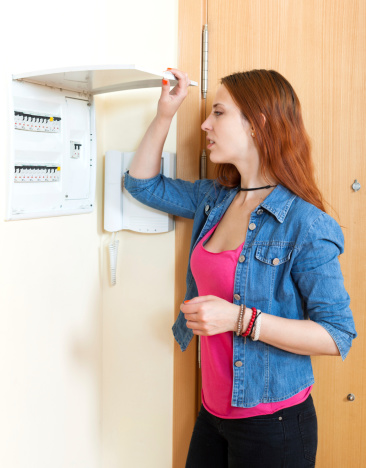
It's happened to most of us at some point: we plug in or turn on a new device--a vacuum cleaner, laptop, lamp or blow dryer—and all the electrical power in the room goes blank.
It can be jarring all right, and it means that the over-current protective device at your home's main electrical panel sensed trouble, tripped open the circuit breaker and shut off the power. (In much older homes, a fuse will “blow"). This three-step process prevents the wires inside the panel from getting too hot and potentially starting a fire.
At this point, you have an overloaded circuit on your hands. Technically, this means that the total electrical load has exceeded 1,800 watts for an 15-amp circuit, which most homes are. (The load limit for a 20-amp circuit is 2,400 watts).
The short-term solution is to simply plug the device into another outlet—preferably a general purpose circuit—and flip the circuit breaker back on. But if a circuit trips repeatedly and/or often, a better, longer-term solution is to add up the electrical load so that you can spread it to an “underloaded” circuit or hire a licensed electrician to run a new circuit.
Handling an overloaded circuit is such an important topic that Experts In Your Home is proud to make it part of our ongoing series of articles on do-it-yourself electrical repairs. You might find it to be the most useful and practical article yet—and not nearly as intimidating as it may sound.
Know your panel
The switches (circuit breakers) inside that gray, metal box consist of two different types: dedicated and general purpose circuits. The former have their work cut out for them: they power such “big draw” appliances as your furnace, gas range and microwave or serve “big draw” rooms such as kitchens and laundry rooms.
General purpose circuits can serve multiple rooms and hallways. These are often (but not always) the types of circuits that you can plug into for that extra power when everything goes dark or use to add an extra outlet.
Perfect your house map
But first, a floor plan awaits you. Ideally, one is already taped to your electrical panel so that you can easily trace which rooms—and which outlets—run to each and every circuit in the electrical panel. At Experts In Your Home, we find that many home maps are good at identifying dedicated circuits but are not so good at labeling general purpose circuits.
In this case, there really is no “easy” way to bring order to your home's electrical system. You'll have to turn off the circuit breakers and move methodically through your home, testing every outlet by flipping switches on and off and plugging in devices. There's no doubt that the electrical repair will go faster (and you'll have more fun) by working with a partner. While one person “mans” the panel, the other can assume the role of outlet tester.
Set wattage limits
With the circuits identified, consult a handy U.S. Department of Energy guide to ensure that the wattage on any one circuit does not exceed 1,800 watts. Add up only those devices you use regularly, but give yourself a little breathing room too. In other words, load your circuits to within only 80 percent of their capacity, or 1,440 watts. This way, when you plug in a high-wattage device, you'll be less likely to overload a circuit.
Making sense of your home's electrical system can be great fun, though if you're not used to working with it every day, it can be enough to overload your internal circuits. In this case, don't hesitate for a moment to reach out to an expert Chico electrician at Experts In Your Home to help with your future electrical repairs.
Related Articles:
9 Electrical Repairs You Should Take Care of ASAP
Questions to Ask Before Attempting a DIY Electrical Repair
Stay safer in your home: find out which electrical jobs to hire a pro for with this FREE guide:








